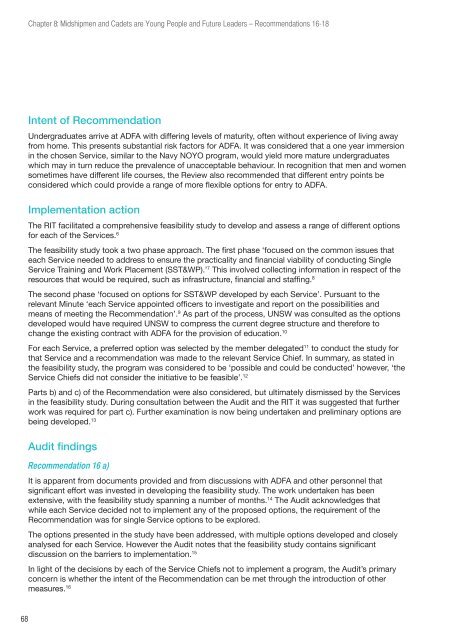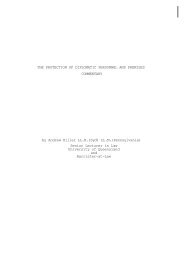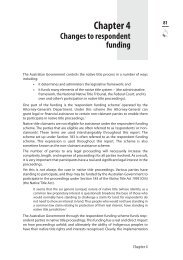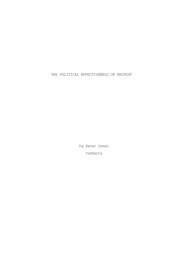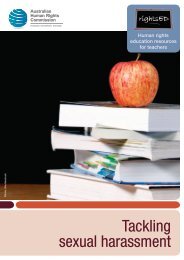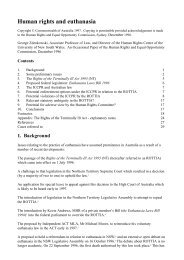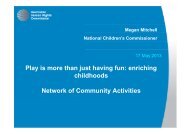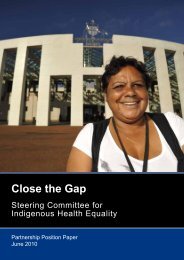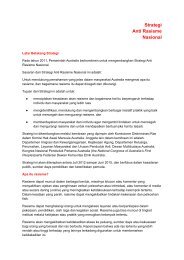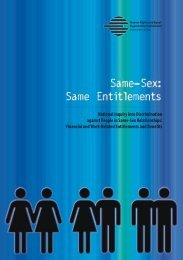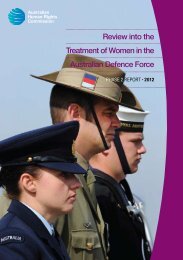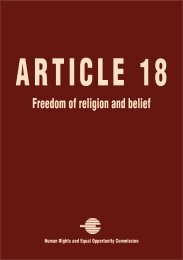Review into the treatment of women at the Australian Defence Force ...
Review into the treatment of women at the Australian Defence Force ...
Review into the treatment of women at the Australian Defence Force ...
- No tags were found...
Create successful ePaper yourself
Turn your PDF publications into a flip-book with our unique Google optimized e-Paper software.
Chapter 8: Midshipmen and Cadets are Young People and Future Leaders – Recommend<strong>at</strong>ions 16-18Intent <strong>of</strong> Recommend<strong>at</strong>ionUndergradu<strong>at</strong>es arrive <strong>at</strong> ADFA with differing levels <strong>of</strong> m<strong>at</strong>urity, <strong>of</strong>ten without experience <strong>of</strong> living awayfrom home. This presents substantial risk factors for ADFA. It was considered th<strong>at</strong> a one year immersionin <strong>the</strong> chosen Service, similar to <strong>the</strong> Navy NOYO program, would yield more m<strong>at</strong>ure undergradu<strong>at</strong>eswhich may in turn reduce <strong>the</strong> prevalence <strong>of</strong> unacceptable behaviour. In recognition th<strong>at</strong> men and <strong>women</strong>sometimes have different life courses, <strong>the</strong> <strong>Review</strong> also recommended th<strong>at</strong> different entry points beconsidered which could provide a range <strong>of</strong> more flexible options for entry to ADFA.Implement<strong>at</strong>ion actionThe RIT facilit<strong>at</strong>ed a comprehensive feasibility study to develop and assess a range <strong>of</strong> different optionsfor each <strong>of</strong> <strong>the</strong> Services. 6The feasibility study took a two phase approach. The first phase ‘focused on <strong>the</strong> common issues th<strong>at</strong>each Service needed to address to ensure <strong>the</strong> practicality and financial viability <strong>of</strong> conducting SingleService Training and Work Placement (SST&WP).’ 7 This involved collecting inform<strong>at</strong>ion in respect <strong>of</strong> <strong>the</strong>resources th<strong>at</strong> would be required, such as infrastructure, financial and staffing. 8The second phase ‘focused on options for SST&WP developed by each Service’. Pursuant to <strong>the</strong>relevant Minute ‘each Service appointed <strong>of</strong>ficers to investig<strong>at</strong>e and report on <strong>the</strong> possibilities andmeans <strong>of</strong> meeting <strong>the</strong> Recommend<strong>at</strong>ion’. 9 As part <strong>of</strong> <strong>the</strong> process, UNSW was consulted as <strong>the</strong> optionsdeveloped would have required UNSW to compress <strong>the</strong> current degree structure and <strong>the</strong>refore tochange <strong>the</strong> existing contract with ADFA for <strong>the</strong> provision <strong>of</strong> educ<strong>at</strong>ion. 10For each Service, a preferred option was selected by <strong>the</strong> member deleg<strong>at</strong>ed 11 to conduct <strong>the</strong> study forth<strong>at</strong> Service and a recommend<strong>at</strong>ion was made to <strong>the</strong> relevant Service Chief. In summary, as st<strong>at</strong>ed in<strong>the</strong> feasibility study, <strong>the</strong> program was considered to be ‘possible and could be conducted’ however, ‘<strong>the</strong>Service Chiefs did not consider <strong>the</strong> initi<strong>at</strong>ive to be feasible’. 12Parts b) and c) <strong>of</strong> <strong>the</strong> Recommend<strong>at</strong>ion were also considered, but ultim<strong>at</strong>ely dismissed by <strong>the</strong> Servicesin <strong>the</strong> feasibility study. During consult<strong>at</strong>ion between <strong>the</strong> Audit and <strong>the</strong> RIT it was suggested th<strong>at</strong> fur<strong>the</strong>rwork was required for part c). Fur<strong>the</strong>r examin<strong>at</strong>ion is now being undertaken and preliminary options arebeing developed. 13Audit findingsRecommend<strong>at</strong>ion 16 a)It is apparent from documents provided and from discussions with ADFA and o<strong>the</strong>r personnel th<strong>at</strong>significant effort was invested in developing <strong>the</strong> feasibility study. The work undertaken has beenextensive, with <strong>the</strong> feasibility study spanning a number <strong>of</strong> months. 14 The Audit acknowledges th<strong>at</strong>while each Service decided not to implement any <strong>of</strong> <strong>the</strong> proposed options, <strong>the</strong> requirement <strong>of</strong> <strong>the</strong>Recommend<strong>at</strong>ion was for single Service options to be explored.The options presented in <strong>the</strong> study have been addressed, with multiple options developed and closelyanalysed for each Service. However <strong>the</strong> Audit notes th<strong>at</strong> <strong>the</strong> feasibility study contains significantdiscussion on <strong>the</strong> barriers to implement<strong>at</strong>ion. 15In light <strong>of</strong> <strong>the</strong> decisions by each <strong>of</strong> <strong>the</strong> Service Chiefs not to implement a program, <strong>the</strong> Audit’s primaryconcern is whe<strong>the</strong>r <strong>the</strong> intent <strong>of</strong> <strong>the</strong> Recommend<strong>at</strong>ion can be met through <strong>the</strong> introduction <strong>of</strong> o<strong>the</strong>rmeasures. 1668


